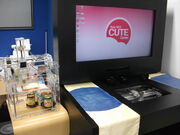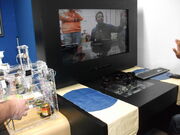Report for Presentation and Demonstration at NEC
Wang Xuan
NEC C&C Innovation Research Lab visit
Purpose: project final presentation and demostration Project Name: Kitchen Media
Dates : 05/03/2011 – 12/03/2011
Location : NEC - R&D Center in Osaka, Japan
Six people from Cute Center of Singapore went to the NEC R&D lab for the final presentation and demostration. This joint project between NEC and Keio-NUS Cute center has been on for 2 years. During the 2nd year, we developed a whole co-ding system, to create a sense of co-presence for family members who are located in diffferent places. The system uses technology to bond family through meaningful communication using food and dinning channels.
The co-dining table is implemented with four devices: food printer, moving object table, a table cloth display and a screen for gesture-based interaction.
Demo set up:
We arrived at NEC C&C lab on early Monday morning. There was some issues with the DHL and our parcles were delayed. Luckily they were delivered aournd 4pm in the afternoon, so we immediately started setting up the demo.
There was no network in the lab, so we were not able to test the communication part of our system. And the screen interaction with all sub-systems cannot be tested until the whole system has been set up. So I helped the others to set up the physical system first. When we open the boxes, we found that many parts of the food printer has been broken into pieces. We had to carefully examine the broken parts and identify which belongs to where, and glue them back together again using super glue. The axis of the printer was also broken, and it took us a long time to adjust them back to the orginal position.
On the second day we continued to work in the lab to set up everything. It was a long day. We had some problems setting up the TV, because it was bought in Japan and the menu and handbook are all in Japanese! In the end we were able to get the correct settings. As there was still no internet in the lab, we decided to run the demo locally instead of remotely. So I modified the program to make it run locally at a higher resolution. At the end of the day, we managed to connect everything together and the system looked good to go! However, time was still limited because we hadn't had time to test the whole system yet, and we only had the next morning to finish everything.

Therefore, on the demo day, we again arrived early in NEC and started testing the system. It turned out the as the kinect is installed at the bottom of the screen, we needed to change the positions of the icons from the bottom of the screen to the top, because otherwise the table blocked the hand and the user was not able to reach the bottons on the bottom. So I did the change and tested with the food printer, the table cloth and the moving table. It seemed to be working fine.

The demo:
Prof Cheok arrived at 2pm and the presentation and demo started. Veronica did an excellent presentation to NEC and the crowd then moved to the demo area. I was very nervous and stressed at that time, because the screen program is the central part of the system which connects and controls every sub-system. If it did not work then we would not be able to show the demo at all. Luckily it went well generally and everyone was excited and happy to see the system working. Many of them, including Yamada san, actually sat in the chair to test out the sytem themselves. One thing I regret is that we should have explained the gestures clearly before inviting people to try out the system. The gestures had been so natural to me because I had done it for so many times, but I forgot that first time users may not find it very easy. Indeed, it turned out some of them had some difficulty performing the set of gestures to send the signal at the first. After a few attemps, they managed to get it working. In addition, as there were many people around to see the demo and many were in the camera view, the program crashed while trying to handle so much information and calculation. We quickly restarted the program and it worked fine. Previously, we only tested with only one or two person in front of the camera, and we should have done some stress test of the system. Generally speaking, the demo was very successful and NEC seemed to be happy about our work.

After the demo, Prof Cheok took us to Kyoto University to visit Prof Tosa's lab. She explained her works on Cultural Computing and showed us some videos of her projects, including some amazing ones dated back to as early as the 1990s. She also demoed to us an iPhone/iPad app of the Shanshui painting project, which was really interesting.
Finishing up:
After the demo day, we went to NEC to finish up the work there -- to make the system more robust, pack the food printer, clean up the space, as well as testing out the intenet connection. We were able to run the remote version of the program using two computers through wifi network, but the video quality was not so good because the wifi network there was quite slow and unstable. We explained to Kato san on how to use the system. In the future we are going to test out the connection between NEC and Singapore, and also make our system more robust in unstable network conditions.
In all, it has been a hectic week and everyone worked very hard. We are very glad and proud that we finally made it!